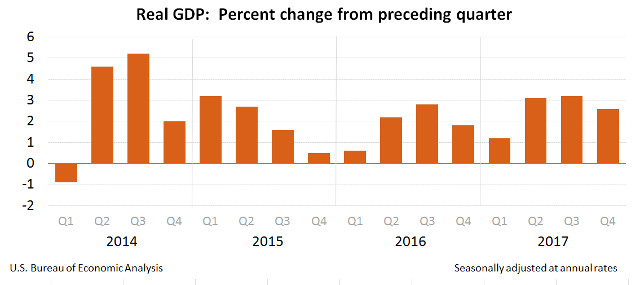Washington, DC…Real gross domestic product (GDP) increased at an annual rate of 2.6 percent in the fourth quarter of 2017 (table 1), according to the “advance” estimate released by the Bureau of Economic Analysis. In the third quarter, real GDP increased 3.2 percent. The Bureau emphasized that the fourth-quarter advance estimate released today is based on source data that are incomplete or subject to further revision by the source agency (see “Source Data for the Advance Estimate” on page 3). The “second” estimate for the fourth quarter, based on more complete data, will be released on February 28, 2018.


The increase in real GDP in the fourth quarter reflected positive contributions from personal consumption expenditures (PCE), nonresidential fixed investment, exports, residential fixed investment, state and local government spending, and federal government spending that were partly offset by a negative contribution from private inventory investment. Imports, which are a subtraction in the calculation of GDP, increased (table 2). The deceleration in real GDP growth in the fourth quarter reflected a downturn in private inventory investment that was partly offset by accelerations in PCE, exports, nonresidential fixed investment, state and local government spending, and federal government spending, and an upturn in residential fixed investment. Imports, which are a subtraction in the calculation of GDP, turned up. Current-dollar GDP increased 5.0 percent, or $238.3 billion, in the fourth quarter to a level of $19,738.9 billion. In the third quarter, current-dollar GDP increased 5.3 percent, or $250.6 billion (table 1 and table 3). The price index for gross domestic purchases increased 2.5 percent in the fourth quarter, compared with an increase of 1.7 percent in the third quarter (table 4). The PCE price index increased 2.8 percent, compared with an increase of 1.5 percent. Excluding food and energy prices, the PCE price index increased 1.9 percent, compared with an increase of 1.3 percent (appendix table A). Personal Income (table 10) Current-dollar personal income increased $178.9 billion in the fourth quarter, compared with an increase of $112.3 billion in the third. The acceleration in personal income primarily reflected an upturn in personal interest income and an acceleration in nonfarm proprietors’ income. Disposable personal income increased $139.0 billion, or 3.9 percent, in the fourth quarter, compared with an increase of $73.8 billion, or 2.1 percent, in the third. Real disposable personal income increased 1.1 percent, compared with an increase of 0.5 percent. Personal saving was $384.4 billion in the fourth quarter, compared with $478.3 billion in the third. The personal saving rate -- personal saving as a percentage of disposable personal income -- was 2.6 percent in the fourth quarter, compared with 3.3 percent in the third. 2017 GDP Real GDP increased 2.3 percent in 2017 (that is, from the 2016 annual level to the 2017 annual level), compared with an increase of 1.5 percent in 2016 (table 1). The increase in real GDP in 2017 primarily reflected positive contributions from PCE, nonresidential fixed investment, and exports. Imports, which are a subtraction in the calculation of GDP, increased (table 2). The acceleration in real GDP from 2016 to 2017 reflected upturns in nonresidential fixed investment and in exports and a smaller decrease in private inventory investment. These movements were partly offset by decelerations in residential fixed investment and in state and local government spending. Imports, which are a subtraction in the calculation of GDP, accelerated. Current-dollar GDP increased 4.1 percent, or $762.3 billion, in 2017 to a level of $19,386.8 billion, compared with an increase of 2.8 percent, or $503.8 billion, in 2016 (table 1 and table 3). The price index for gross domestic purchases increased 1.8 percent in 2017, compared with an increase of 1.0 percent in 2016 (table 4). The PCE price index increased 1.7 percent, compared with an increase of 1.2 percent. Excluding food and energy prices, the PCE price index increased 1.5 percent, compared with an increase of 1.8 percent (appendix table A). During 2017 (measured from the fourth quarter of 2016 to the fourth quarter of 2017), real GDP increased 2.5 percent, compared with an increase of 1.8 percent during 2016. The price index for gross domestic purchases increased 1.9 percent during 2017, compared with an increase of 1.4 percent during 2016 (table 7). Source Data for the Advance Estimate Information on the assumptions used for unavailable source data in the advance estimate is provided in a Technical Note that is posted with the news release on BEA’s Web site. A detailed "Key Source Data and Assumptions" file is also posted for each release. For information on updates to GDP, see the "Additional Information" section that follows. * * * Next release: February 28, 2018 at 8:30 A.M. EST Gross Domestic Product: Fourth Quarter 2017 (Second Estimate) * * * Additional Information Release Dates in 2018 Estimate 2017: IV and annual 2018: I 2018: II 2018: III Gross Domestic Product Advance January 26 April 27 July 27 October 26 Second February 28 May 30 August 29 November 28 Third March 28 June 28 September 27 December 21 Corporate Profits Preliminary … May 30 August 29 November 28 Revised March 28 June 28 September 27 December 21 Additional Information Resources Additional resources available at www.bea.gov: • Stay informed about BEA developments by reading the BEA blog, signing up for BEA’s email subscription service, or following BEA on Twitter @BEA_News. • Historical time series for these estimates can be accessed in BEA’s Interactive Data Application. • Access BEA data by registering for BEA’s Data Application Programming Interface (API). • For more on BEA’s statistics, see our monthly online journal, the Survey of Current Business. • BEA's news release schedule • NIPA Handbook: Concepts and Methods of the U.S. National Income and Product Accounts Definitions Gross domestic product (GDP) is the value of the goods and services produced by the nation’s economy less the value of the goods and services used up in production. GDP is also equal to the sum of personal consumption expenditures, gross private domestic investment, net exports of goods and services, and government consumption expenditures and gross investment. Current-dollar estimates are valued in the prices of the period when the transactions occurred—that is, at “market value.” Also referred to as “nominal estimates” or as “current-price estimates.” Real values are inflation-adjusted estimates—that is, estimates that exclude the effects of price changes. The gross domestic purchases price index measures the prices of final goods and services purchased by U.S. residents. The personal consumption expenditure price index measures the prices paid for the goods and services purchased by, or on the behalf of, “persons.” Personal income is the income received by, or on behalf of, all persons from all sources: from participation as laborers in production, from owning a home or business, from the ownership of financial assets, and from government and business in the form of transfers. It includes income from domestic sources as well as the rest of world. It does not include realized or unrealized capital gains or losses. Disposable personal income is the income available to persons for spending or saving. It is equal to personal income less personal current taxes. Personal outlays is the sum of personal consumption expenditures, personal interest payments, and personal current transfer payments. Personal saving is personal income less personal outlays and personal current taxes. The personal saving rate is personal saving as a percentage of disposable personal income. (For a comparison of personal saving in BEA's national income and product accounts (NIPAs) with personal saving in the Federal Reserve Board's financial accounts of the United States, go to www.bea.gov/national/nipaweb/nipa-frb.asp. For more definitions, see the Glossary: National Income and Product Accounts. Statistical conventions Annual rates. Quarterly values are expressed at seasonally-adjusted annual rates (SAAR), unless otherwise specified. Dollar changes are calculated as the difference between these SAAR values. For detail, see the FAQ “Why does BEA publish estimates at annual rates?” Percent changes in quarterly series are calculated from unrounded data and are displayed at annual rates, unless otherwise specified. For details, see the FAQ “How is average annual growth calculated?” Quantities and prices. Quantities, or “real” volume measures, and prices are expressed as index numbers with a specified reference year equal to 100 (currently 2009). Quantity and price indexes are calculated using a Fisher-chained weighted formula that incorporates weights from two adjacent periods (quarters for quarterly data and annuals for annual data). “Real” dollar series are calculated by multiplying the published quantity index by the current dollar value in the reference year (2009) and then dividing by 100. Percent changes calculated from real quantity indexes and chained-dollar levels are conceptually the same; any differences are due to rounding. Chained-dollar values are not additive because the relative weights for a given period differ from those of the reference year. In tables that display chained-dollar values, a “residual” line shows the difference between the sum of detailed chained-dollar series and its corresponding aggregate. Updates to GDP BEA releases three vintages of the current quarterly estimate for GDP: "Advance" estimates are released near the end of the first month following the end of the quarter and are based on source data that are incomplete or subject to further revision by the source agency; “second” and “third” estimates are released near the end of the second and third months, respectively, and are based on more detailed and more comprehensive data as they become available. Annual and comprehensive updates are typically released in late July. Annual updates generally cover at least the 3 most recent calendar years (and their associated quarters) and incorporate newly available major annual source data as well as some changes in methods and definitions to improve the accounts. Comprehensive (or benchmark) updates are carried out at about 5-year intervals and incorporate major periodic source data, as well as major conceptual improvements. The table below shows the average revisions to the quarterly percent changes in real GDP between different estimate vintages, without regard to sign. Vintage Average Revision Without Regard to Sign (percentage points, annual rates) Advance to second 0.5 Advance to third 0.6 Second to third 0.2 Advance to latest 1.3 Note - Based on estimates from 1993 through 2016. For more information on GDP updates, see Revision Information on the BEA Web site. The larger average revision from the advance to the latest estimate reflects the fact that periodic comprehensive updates include major statistical and methodological improvements. Unlike GDP, an advance current quarterly estimate of GDI is not released because data on domestic profits and on net interest of domestic industries are not available. For fourth quarter estimates, these data are not available until the third estimate.


